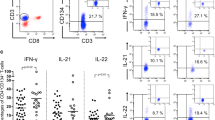Summary
The expression of inducible co-stimulator (ICOS) in peripheral blood T lymphocytes from the patients with systemic lupus erythematosus (SLE) and the role in the pathogenesis of SLE was investigated. By using two-color immunofluorescent staining and flow cytometric assay, the expression levels of ICOS in peripheal blood T lymphocytes from 33 patients with SLE and 16 healthy volunteers were detected. SLE diseases activity index (SLEDAI) of the patients with SLE was used to evaluate the disease activity. The correlation between the ICOS expression and SLEDAI was analyzed among the groups. The results showed that the expression levels of ICOS in T lymphocytes in active SLE group was markedly higher than those in the control and inactive SLE groups (bothP< 0.01). There was no significant difference in the expression levels of ICOS between the inactive SLE and the control groups (P>0.05). In active SLE and inactive SLE groups, positive linear correlation was found between the levels of the ICOS expression in T lymphocytes and SLEDAI (r=0. 711,P=0.001;r=0.561,P=0.03). It was suggested that the expression of ICOS in peripheral blood T lymphocytes from the patients with active SLE was up-regulated and and ICOS might be related to the pathogenesis of SLE.
Similar content being viewed by others
References
Criscione L G, Pisetsky D S. B lymphocytes and systemic lupus erythematosus. Curr Rheumatol Rep, 2003, 5(4):264
Seo S J, Fields M L, Buckler J Let al. The impact of T helper and T regulatory cells on the regulation of antidouble-stranded DNA B cells. Immunity, 2002, 16(4):535
Hutloff A, Dittrich A M, Beier K Cet al. ICOS is an inducible T-cell costimulator structurally, and functionally related to CD28. Nature, 1999, 397(6716):263
Iwai H, Abe M, Hirose Set al. Involvement of inducible costimulator-B7 homologous protein costimulatory pathway in murine lupus nephritis. J Immunol, 2003, 171(6): 2848
Bombardier C, Gladman D D, Urowitz M Bet al. Derivation of the SLEDAI: a disease activity index for lupus patients. The Committee on Prognosis Studies in SLE. Arthritis Rheum, 1992, 35:630
Mages H W, Hutloff A, Heuck Cet al. Molecular cloning and characterization of murine ICOS and identification of B7h as ICOS ligand. Eur J Immunol, 2000, 30(4): 1040
McAdam A J, Greenwald R J, Levin M Aet al. Icos is critical for CD40-mediated antibody class switching. Nature, 2001, 409(6816):102
Suh W K, Tafuri A, Berg-Brown N Net al. The inducible costimulator plays the major costimulatory role in humoral immune responses in the absence of CD28. J Immunol, 2004, 172(10):5917
Horwitz D A, Tang F L, Stimmler M Met al. Decrease T cell response to anti-CD2 in systemic lupus erythematosus and reversal by anti-CD28: evidence for imperied T cell-accessory cell interaction. Arthritis Rheum, 1997, 40 (5):822
Author information
Authors and Affiliations
Additional information
CHEN Zhiping, male, born in 1972, Postgraduate Student
Rights and permissions
About this article
Cite this article
Zhiping, C., Zhenfu, L., Shunhua, Z. et al. Expression of inducible co-stimulator in peripheral blood T lymphocytes in the patients with systemic lupus erythematosus. Current Medical Science 25, 357–359 (2005). https://doi.org/10.1007/BF02828167
Received:
Published:
Issue Date:
DOI: https://doi.org/10.1007/BF02828167




